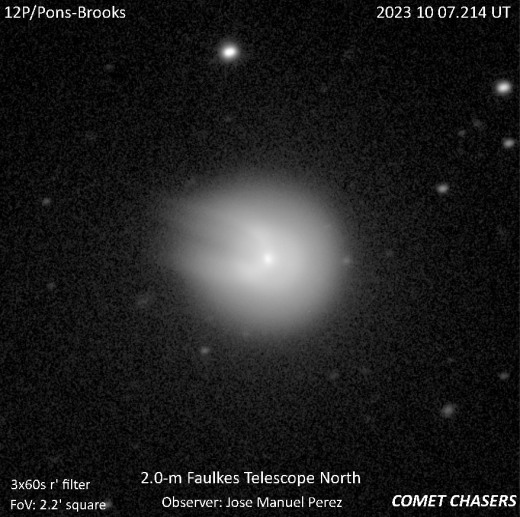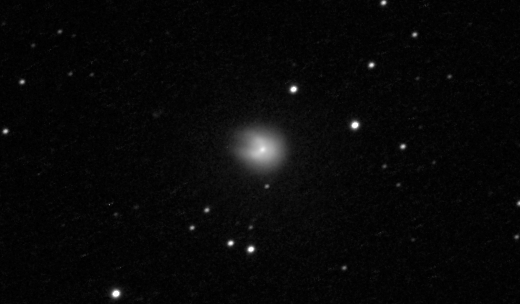Oct. 8, 2023 : (Spaceweather.com) For the second time this year, a cryovolcanic eruption on Comet 12P/Pons-Brooks has expelled a cloud of debris in the shape of the Millennium Falcon. It was weird enough the first it happened in July. Now, in October, scientists are confronted with the challenge of explaining how a comet can shapeshift itself into a Star Wars freighter twice:

This image was taken on Oct. 7, 2023, by Jose Manual Perez of the Comet Chasers, the same group that discovered the outburst two days earlier. The double horns of the Falcon look just like they did in July 2023.
Richard Miles of the British Astronomical Association thinks 12P may be one of 10 to 20 known comets with active ice volcanoes. “The two ‘horns’ may be caused by a peculiarly-shaped cryovolcanic vent with some sort of blockage causing material to be expelled with a weird flow pattern,” he speculates.
This is *not* just a funny-shaped comet tail, he stresses. Miles used a JPL ephemeris to compare the direction of the horns with the expected direction of the comet’s dust and ion tails. It was a complete mismatch.
“The difference between the July horns and its October ones is about 55-60° projected on the sky,” says Miles. “The mismatch between either of these directions and the ion tail direction and dust tail direction was almost the most it could be!
Amateur astronomer Lars Zielke of Tvis, Denmark, has been tracking the outburst every night. This animation shows the change in only 24 hours (Oct. 7-8):

“What a difference in size!” says Zielke. “I think there is a hint of a globular dust cloud expanding around the comet’s core, and it is easy to see the expansion of the ‘horns’ of the Falcon.”
Comet 12P could attract widespread interest next year–especially if it continues to explode. The comet is falling toward the sun for a close encounter in April 2024 when it is expected to become a naked-eye object at 4th or 5th magnitude. Talk about perfect timing. 12P will reach maximum brightness only a few days before the total solar eclipse on April 8, 2024. Sky watchers in the path of totality could look up and see an outburst for themselves.
Amateur astronomers are encouraged to monitor developments. After its latest outburst, the comet is shining as brightly as an 11th magnitude star, putting it within range of mid-sized backyard telescopes. Look for 12P in the constellation Hercules just across the border from the bright star Vega. [sky map]